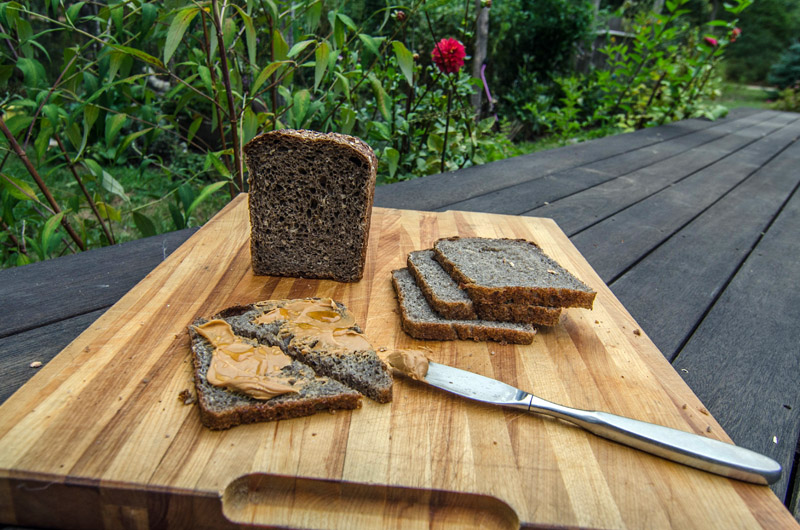Olivia Pattison’s buckwheat loaf is so good it will make you crazy, but not in a scary way. Not like ergot, a grain fungus in the rye, can. Ergot contamination, some believe, caused the problems in Salem in 1691. The seizures and hallucinations that led to the witch trials they say, started with bad bread. Be assured, the transformations brought on by Olivia’s handiwork are not like that at all. Her bread brings a happy high: eat a slice and you feel like things in the world are lining up and you appreciate how satisfying, wondrous and unusual that is. Tall and toastable, the evenly-formed crumb of Olivia’s end-of-summer baking triumph is a rich color that is hard to name, thanks to the buckwheat. Buckwheat is an old grain that is not a grain at all. It is a pseudo-cereal, the seed of a botanical relative of sorrel and rhubarb. Today it is sown in New England chiefly as a cover crop because it establishes quickly and grows rapidly. A few years back, flower-grower Krishana Collins planted her front meadow with it to revitalize the soil and choke out weeds — which the buckwheat did very efficiently. Krishana was so enchanted by the delicate blossoms the plant produced she found it hard to plow it under — the buckwheat, Krishana says, was magical.
It is not a grass and contains no gluten. Scholars tells us buckwheat was domesticated around 6000 BC, moved from Asia to Europe, and then across the ocean to New England. It is highly nutritious, a rich source of protein, dietary fiber, vitamins, and minerals. Buckwheat groats (kasha) remain popular in Eastern Europe, buckwheat blini are beloved in Russia, and buckwheat soba noodles are relished in Japan.
Olivia likes the nutty flavor of buckwheat flour. She gets hers from Maine Grain, a grist mill and flour distributer which sells only grains grown in northern New England. She also gets her oats there, using cracked oats not rolled. She believes in the value of eating grain as whole as possible. She also finds cracked oats have more flavor, but they need to be handled properly, she cautions. She soaks hers in hot water overnight, letting them fully hydrate before she incorporates them into her intentionally wet dough. Like many artisan bakers, Olivia believes full hydration makes bread more digestible. “It’s like cooking rice, you need to add enough water,” she says. “In addition to the off-Island grains, Olivia adds flour ground from Vineyard wheat.
Dan Sternbach is now growing Red Fife wheat (and emmer and rye) in West Tisbury. The usually damp climate is a challenge, but one Dan is facing with success. He is now selling Island-grown wheat to local bakers including Olivia. For Dan and his collaborator in the local wheat project, Allen Healy of Mermaid Farm, the product is well worth the care and testing required to insure that the local grain remains a healthful pleasure (there will be no ergot contamination here). Olivia loves the idea of Vineyard wheat and the fact that Dan grinds her order when she calls it in. This preserves the flavor, something she believes you notice with each bite.
Besides the grains, the secret to Olivia’s Buckwheat-Oat Bread is the starter. A starter is a home-grown culture used in place of commercial yeast to leaven bread. Mix flour with water and leave it at room temperature until it bubbles — a couple of days—and you have a starter. That’s what Olivia did in 2013 at the Beach Plum Inn when she started as pastry chef. She has been feeding hers since— once a day, except on baking days, then two times.
Olivia baked all summer for the Wednesday farmers’ market. Her breads can still be found at the Scottish Bakehouse midweek and on Saturdays and will be availaible at the winter market.
Be warned though: Olivia’s schedule is set, but like the ancient grains she prefers, she is not entirely predictable. Plan to buy her Buckwheat-Oat Bread and you may find she has a fresh corn kernel filled-loaf instead. Honestly, that’s okay. All Olivia’s breads are very good — just be sure to buy the buckwheat when you see it.
Pan con Tomate (Tomato Toast)
Serves two
This is one of the very best things you can make with perfect tomatoes, a Spanish favorite both with drinks and for breakfast. Begin by picking a tender-firm red tomato or two (field tomatoes work better than large, super juicy heirlooms). Cut the tomato in half. Toast slices of good bread — Buckwheat Oat is perfect. While still warm, rub the bread with the tomato or if you like your toast saucier, use a large-holed grater to puree the tomato, then spoon the pulp on the slices of toast. Drizzle with good extra virgin olive oil, sprinkle with sea salt and serve.
Chris Fischer is chef at The Covington restaurant in Edgartown. His 2015 Beetlebung Farm Cookbook won a James Beard award for American cooking. Catherine Young collaborates with him on writing and recipes.





Comments
Comment policy »